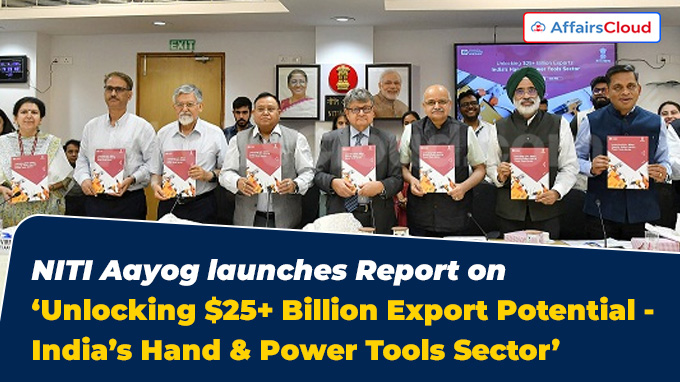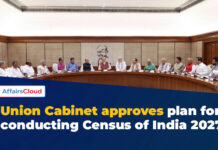 In April 2025, New Delhi (Delhi) based National Institution for Transforming India (NITI) Aayog launched a report titled “Unlocking USD25+ Billion Export Potential – India’s Hand & Power Tools Sector.” It indicates that India can achieve USD 25+ billion (Rs. 2,13,925+ crore) in exports within the next 10 years, capturing 25% of the global hand tools market and 10% of the global power tools market.
In April 2025, New Delhi (Delhi) based National Institution for Transforming India (NITI) Aayog launched a report titled “Unlocking USD25+ Billion Export Potential – India’s Hand & Power Tools Sector.” It indicates that India can achieve USD 25+ billion (Rs. 2,13,925+ crore) in exports within the next 10 years, capturing 25% of the global hand tools market and 10% of the global power tools market.
- The report was released by Suman Bery, Vice Chairman (VC) of NITI Aayog in the presence of BVR Subrahmanyam, Chief Executive Officer (CEO) of NITI Aayog, Dr Vijay Kumar Saraswat, Member of NITI Aayog, and Dr. Arvind Virmani, Member of NITI Aayog.
- This creates approximately 35 lakh jobs through MSME (Micro, Small, and Medium Enterprises) empowerment and industrial ecosystem development.
Key Highlights:
The report highlights the transformative role of India’s Hand and Power Tools sector in accelerating economic growth and outlines a roadmap to enhance global competitiveness and strengthen India’s manufacturing ecosystem.
1.Global Market Potential:
India’s share in the global hand and power tools trade is currently valued at USD 100 billion and is expected to grow to USD 190 billion by 2035.
- Hand tools presently constitute USD 34 billion, projected to rise to USD 60 billion by 2035.
- Power tools, including accessories, are valued at USD 63 billion, expected to grow to USD 134 billion by 2035, with electrical tools comprising the major share.
2.Current Global Market Share:
i.China leads the global export market by holding 50% (USD 13 billion) of the hand tools market and 40% (USD 22 billion) of the power tool exports.
ii.India’s share remains modest at 1.8% (USD 600 million) in hand tools and 0.7% (USD 470 million) in power tools.
3.Challenges Identified:
India faces a 14-17% cost disadvantage over China due to elevated raw material prices (steel, plastic, motors), lower labour productivity from overtime wage restrictions, higher interest and logistics costs, especially from inland states to ports
4.Strategic Interventions Proposed:
i.Developing World-Class Industrial Clusters:
- Establish 3–4 clusters across 4,000 acres under a Public-Private Partnership (PPP) model.
- Provide plug-and-play facilities, worker housing, convention centers, and enhanced connectivity
ii.Structural Reforms to Reduce Costs:
- Lower tariffs on critical raw materials like steel and machinery.
- Increase allowable working hours to 10 hours/day and 60 hours/week, cap overtime wages at 1.25–1.5x (rather than 2x).
- Simplify the Export Promotion Capital Goods (EPCG) scheme and ease Authorized Economic Operator (AEO) requirements.
iii.Financial Support Mechanisms:
An additional Rs. 8,000 crores in bridge support will be necessary if the structural reforms are not adopted, and this investment could yield 2-3 times its value in tax revenue in the next five years.
About National Institution for Transforming India (NITI) Aayog:
Chief Executive Officer (CEO) – B.V.R. Subrahmanyam
Headquarters – New Delhi, Delhi
Established – 2015




